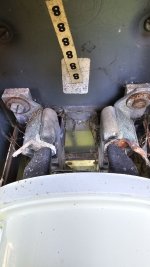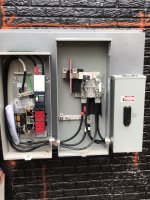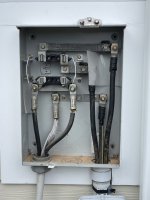LMichaels
TVWBB 2-Star Olympian
So, due to a failure inside my breaker panel on one lug I nearly had a fire if I'd started my AC unit a couple months back. Well, it manifested as a "failure code" on my smart thermostat prompting me to call the HVAC contractor for repair. Thankfully he found the burned lug in my double breaker before something awful happened. He made a repair, installed a new breaker (yes I could have done this myself but I felt indebted to simply follow through with him)
In any case, he ended by telling my I should not trust it for long.
Well my lifelong friend has extensive experience wiring panels so he said we could do it. BTW we're going to pull out the aluminum feed wire from the meter into the house, replace it with copper with soldered on lugs as well.
On opening the meter housing to inspect what we'd be working with we found the meter lugs incredibly corroded. We're thinking it might be good to give it a spray down with a penetrant ahead of time. WD40 perhaps?
Is there any danger to doing this? If due to WD40 is there something else better to use? Or should we just "wing it" and yank it out?
In any case, he ended by telling my I should not trust it for long.
Well my lifelong friend has extensive experience wiring panels so he said we could do it. BTW we're going to pull out the aluminum feed wire from the meter into the house, replace it with copper with soldered on lugs as well.
On opening the meter housing to inspect what we'd be working with we found the meter lugs incredibly corroded. We're thinking it might be good to give it a spray down with a penetrant ahead of time. WD40 perhaps?
Is there any danger to doing this? If due to WD40 is there something else better to use? Or should we just "wing it" and yank it out?



